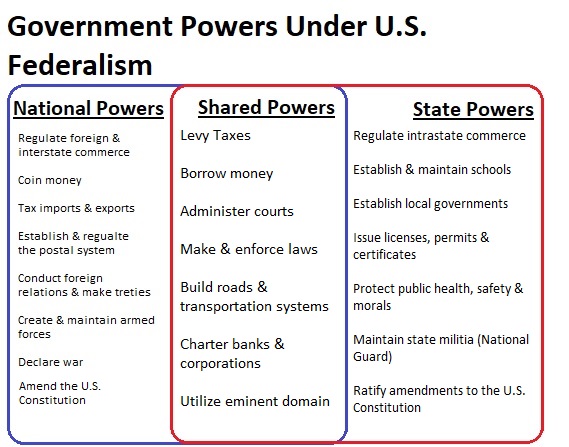2.1-What is Federalism
2.1-What is Federalism Important Formulae
You are currently studying
Grade 10 → Civics → Federalism → 2.1-What is Federalism
- Analyse federal provisions and institutions.
2.1 - What is Federalism
- Federalism is a system of government where power is divided between a central authority and smaller political units (states or provinces).
- In a federal system, both levels of government have their own jurisdiction and can make laws on different matters.
- The Constitution defines the powers of the central government and the state governments.
- Federalism allows unity while maintaining diversity in a country.
- The division of powers is often outlined in a written constitution.
- Example: India, USA, Canada, and Australia are federal countries.
Federalism is a system of governance in which power is divided between a central authority and various regional or local governments. This structure is designed to accommodate diversity, promote local governance, and ensure that different communities have a voice in decision-making processes.
Key Features of Federalism
- Division of Powers: Federalism entails a clear division of powers between the central government and state or regional governments. Each level of government has its own set of responsibilities and areas of jurisdiction, ensuring a balance of authority.
- Written Constitution: A federal system is usually outlined in a written constitution that specifies the powers and responsibilities of each level of government, providing a legal framework for governance.
- Supremacy of the Constitution: In a federal structure, the constitution is the supreme law. Any law that conflicts with the constitution can be challenged in a court of law, ensuring adherence to the established governance framework.
- Independent Judiciary: An independent judiciary plays a crucial role in interpreting the constitution and resolving disputes between different levels of government, ensuring justice and the rule of law.
Types of Federalism
Federalism can take various forms, which may differ based on how power is distributed:
- Dual Federalism: This model emphasizes a clear separation of powers between the central and state governments. Each level operates independently within its own sphere of authority.
- Cooperative Federalism: In this model, the central and state governments work collaboratively to address common issues, often leading to shared responsibilities and joint policymaking.
- Competitive Federalism: This form encourages competition between states or regions to attract resources and investment, which can foster innovation and efficiency in governance.
Importance of Federalism
Federalism plays a vital role in governance and society for several reasons:
- Accommodation of Diversity: Federalism allows for the accommodation of diverse cultures, languages, and interests within a single political framework, enabling different communities to maintain their unique identities.
- Local Governance: By empowering local governments, federalism facilitates more responsive governance that can address the specific needs and concerns of local populations.
- Prevention of Concentration of Power: Federalism acts as a safeguard against the concentration of power in a single authority, promoting accountability and reducing the risk of authoritarianism.
- Encouragement of Participation: Federalism encourages citizen participation in governance at various levels, enhancing democratic engagement and fostering a sense of ownership in the political process.
Challenges of Federalism
While federalism offers many advantages, it also presents several challenges:
- Coordination Issues: The division of powers can lead to difficulties in coordination between different levels of government, potentially resulting in overlapping responsibilities and conflicts.
- Resource Disparities: Inequalities in resource distribution among states can create disparities in governance and service delivery, affecting the overall effectiveness of the federal system.
- Political Conflicts: Differences in political ideologies and priorities between state and central governments can lead to conflicts, complicating the governance process.
Examples of Federalism
Several countries around the world implement federalism, each with unique characteristics:
- United States: The U.S. has a dual federal system where power is clearly divided between the federal and state governments.
- India: India practices cooperative federalism, with a strong central government but significant powers granted to states.
- Germany: Germany employs a federal structure that balances power between the federal government and its 16 states (Bundesländer).
Understanding federalism is essential for grasping how diverse societies can be governed effectively while ensuring representation and autonomy for various communities.

Tylerlucero84, CC BY-SA 4.0, via Wikimedia Commons
2.1-What is Federalism?
फेडरलिज़्म (Federalism) एक प्रकार की शासन प्रणाली है जिसमें दो या दो से अधिक सरकारें अपने-अपने अधिकारों और कर्तव्यों के साथ मिलकर काम करती हैं। इसमें एक केंद्रीय (राष्ट्रीय) सरकार और राज्य सरकारों के बीच शक्तियों का वितरण होता है। फेडरलिज़्म का उद्देश्य विभिन्न स्तरों पर शासन को अधिक प्रभावी बनाना और विभिन्न क्षेत्रों की विशेष जरूरतों के अनुसार शासन चलाना है।
फेडरलिज़्म को समझने के लिए इसे कुछ प्रमुख तत्वों में बाँटा जा सकता है:
- संविधान द्वारा शक्ति का वितरण: फेडरलिज़्म में, सरकार के विभिन्न स्तरों के बीच अधिकार और शक्तियाँ संविधान द्वारा निर्धारित होती हैं। इसका मतलब है कि केंद्रीय और राज्य सरकारें अपने-अपने क्षेत्र में स्वायत्त होती हैं। उदाहरण के तौर पर, भारतीय संविधान में केंद्रीय और राज्य शक्तियाँ स्पष्ट रूप से निर्धारित की गई हैं।
- स्वायत्तता: प्रत्येक सरकार के पास अपनी-अपनी स्वायत्तता होती है, जो उसे अपने क्षेत्र में निर्णय लेने की स्वतंत्रता देती है। इस स्वायत्तता से दोनों सरकारें अपने-अपने अधिकारों में हस्तक्षेप किए बिना कार्य कर सकती हैं।
- संविधानिक व्यवस्था: फेडरलिज़्म में एक मजबूत संविधान होता है जो दोनों स्तरों के बीच के रिश्तों को नियंत्रित करता है। इसमें यह स्पष्ट होता है कि किस क्षेत्र में कौन सी सरकार शक्तियाँ रखती है।
फेडरलिज़्म की अवधारणा में कुछ महत्वपूर्ण तत्व होते हैं:
- विभाजन की संरचना: इसमें शासन की शक्ति दो या दो से अधिक स्तरों में बाँटी जाती है, जैसे केंद्रीय सरकार और राज्य सरकार। भारत में केंद्रीय सरकार, राज्य सरकार और पंचायत/नगरपालिका जैसी स्थानीय सरकारें शामिल होती हैं।
- दोहरी नागरिकता: फेडरलिज़्म में नागरिकों की दोहरी नागरिकता होती है। इसका मतलब यह है कि एक व्यक्ति के पास दोनों (केंद्रीय और राज्य) स्तरों पर अधिकार होते हैं।
- मुलायम और कठोर संविधान: फेडरलिज़्म में संविधान को संशोधित किया जा सकता है, लेकिन यह संशोधन प्रक्रिया उतनी सरल नहीं होती। भारत में संविधान संशोधन प्रक्रिया कठिन होती है।
फेडरलिज़्म के तहत, सरकारों के बीच शक्तियों का वितरण एक केंद्रीय सूची, राज्य सूची और समवर्ती सूची के माध्यम से किया जाता है:
- केंद्रीय सूची (Union List): इसमें वे विषय आते हैं जिन पर केवल केंद्रीय सरकार कानून बना सकती है। उदाहरण: रक्षा, विदेश नीति, और कराधान।
- राज्य सूची (State List): इसमें वे विषय आते हैं जिन पर केवल राज्य सरकारें कानून बना सकती हैं। उदाहरण: पुलिस, शिक्षा, और स्वास्थ्य।
- समवर्ती सूची (Concurrent List): इसमें वे विषय आते हैं जिन पर केंद्रीय और राज्य सरकार दोनों कानून बना सकती हैं। उदाहरण: आपराधिक कानून, शिक्षा, और श्रम।
फेडरलिज़्म में विभिन्न सरकारों के बीच सहयोग और संवाद की आवश्यकता होती है ताकि वे मिलकर राष्ट्र के विकास में योगदान कर सकें। यह सुनिश्चित करता है कि विभिन्न क्षेत्रों की विशिष्ट आवश्यकताओं को ध्यान में रखते हुए निर्णय लिए जाएं और सभी नागरिकों के अधिकारों का संरक्षण किया जाए।
